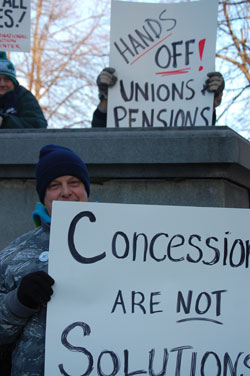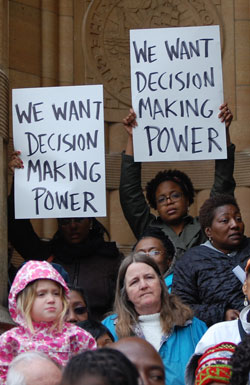Fight for a New Direction for the Economy
• Condemn Government Intervention Against Struggle of Railway Workers
• Autoworkers Must Heed Threats to Their Pensions and Take Appropriate Action to Defend Their Rights
• Capital-Centered Reformism Goes Against the Progressive Trend of History
Condemn Government Intervention Against Struggle of Railway Workers
 President Barack Obama, using executive authority, intervened in the current struggle by railway workers for their rights. He issued an order that blocked a railroad strike called for by more than 25,000 railroad workers. Voice of Revolution condemns this intervention against the workers, which criminalizes their struggle.
President Barack Obama, using executive authority, intervened in the current struggle by railway workers for their rights. He issued an order that blocked a railroad strike called for by more than 25,000 railroad workers. Voice of Revolution condemns this intervention against the workers, which criminalizes their struggle.
Obama is intervening even before the strike has occurred and doing so saying “It’s in our national interest to make sure our freight rail system runs smoothly, since a disruption could affect businesses across the country and cause unnecessary damage to our already-fragile economy.” The impact of rotten conditions on the workers is of no concern. The fact that their just struggle for wages and conditions commensurate with the important work they do positively impacts the economy is also to be denied. Monopoly right — "business interests" — is to dictate with the government acting simply on the basis of a strike vote, to criminalize the workers and public right to safe and modern railways.
Currently, 11 unions representing 92,000 railroad workers are negotiating a contract with the National Carriers’ Conference Committee (NCCC), an industry group representing the major railroad associations. Despite the four largest railroad carriers alone making more than $8.5 billion in profits last year, like other monopolies, they are demanding that workers pay more for healthcare. Older workers and the sick and injured are especially being targeted. The NCCC secured concessions in the contract for the United Transportation Union, representing about 40,000 railway workers, and is using this to insist all other workers submit.
The other eleven unions involved rejected this extortion. On October 3, the Brotherhood of Locomotive Engineers and Trainmen (BLET), one of the largest rail workers unions in the country, representing 25,000 workers, voted to strike on October 7. They were joined by the Brotherhood of Railway Signalmen. Several other unions are considering joining their call for a strike.
Obama is utilizing executive powers put in place in the Railway Labor Act, which governs labor relations in the railway and airline industry and provides the legal basis for limiting the struggle of these workers and sanctioning government intervention to block the right to strike and to resist more generally.
It is also notable that the concerns raised by Obama put forward the notion that it is the workers who are inflicting damage on the economy. This is consistent with the capital-centered view that attacking the workers, lowering their standard of living and eliminating their healthcare and pension benefits are actions that serve the economy. It is an obsolete view that refuses to recognize that to move forward, it is the rights of the workers and their struggle for a new direction for the economy that must be advanced. By defending their rights the workers are also defending the economy in the interests of the public.
As part of the attack on the workers, Obama formed a Presidential Emergency Board comprised of five “mediators” that will have 30 days to recommend a contract. After an additional 30-day cooling-off period, the unions can strike if they reject the contract. However, the Railway Labor Act also allows Congress to unilaterally step in and impose a contract on the workers. The last time railroad workers went on strike in 1991, the strike lasted 14 hours before Congress passed a bill and the president then created a board to unilaterally impose a contract on railroad workers that they had voted to reject.
The current government intervention and the Railway Labor Act that sanctions it serve monopoly right and anti-worker, anti-social demands of the monopolies. Voice of Revolution condemns the government intervention and criminalization of the struggle of the railway workers. What is required is for the workers to strengthen their fight for their rights and for public right, insisting on restricting monopoly right and hold government to account for doing so.
[TOP]
Autoworkers Must Heed Threats to Their Pensions and Take Appropriate Action to
Defend Their Rights
 Threats to the security of GM pensions in the U.S. must be taken seriously. The onslaught on retired autoworker health care benefits began in the U.S. and is also now being imposed in Canada. GM executives made it clear during their campaign to renege on contracted health care benefits that they hold no responsibility for retiree benefits.
Threats to the security of GM pensions in the U.S. must be taken seriously. The onslaught on retired autoworker health care benefits began in the U.S. and is also now being imposed in Canada. GM executives made it clear during their campaign to renege on contracted health care benefits that they hold no responsibility for retiree benefits.
The recently ratified GM/UAW collective agreement contains an addendum entitled: “Pension De-Risk Consideration: 2011 UAW-GM Supplemental Agreement Exhibit A (Pension Plan).”
The letter states in part, “The parties agreed that the national parties may mutually agree during the term of this agreement to amend the [pension] plan to add retirement options for some or all existing retirees to help GM reduce the volatility and risk related to the plan and benefit existing retirees by providing an additional voluntary option.”
This language replicates that used to destroy the system of post-employment health care benefits, which had become for retirees a legal collective claim on GM revenue. GM unilaterally negated retirees claim to secure health care with its introduction of a Health Care Trust (HCT), which once established is no longer funded from company revenue. Retirees did not agree or vote to have their health care benefits reduced and put into an HCT. The HCT was simply declared a necessary part of GM’s anti-worker anti-social restructuring “to reduce the volatility and risk of the existing plan and make the company viable.” No alternative was discussed or allowed to be discussed. GM, with the active instigation of governments, simply dictated the destruction of the existing contracted health care obligation. Retirees did not agree or vote to destroy the contracted health care benefit system and replace it with the HCT that effectively reduces their benefits. GM, the governments and courts forcibly introduced the HCT as part of GM’s anti-worker anti-social restructuring in 2009 and are now putting it into practice.
The current GM/UAW letter “to amend the [pension] plan” implies that GM has the right to change the pension system without the agreement of the retirees who no longer can vote for or against collective agreements. GM says it has the right “to unilaterally terminate” any post-retirement benefit and the letter “Pension De-Risk” reiterates this belief. The fact that it is couched in vague terms such as “voluntary options” and “mutually agree” is meant to fool the gullible and give GM a blank check.
 GM has no right to change the pension system without the conscious participation and informed consent of the retirees. However, retirees can only make their public right to a say in the security of their pensions a reality through restricting GM’s monopoly right to change unilaterally their pension plan. No other force than a united determined opposition by retirees themselves can stop GM’s monopoly right “to add retirement options for some or all existing retirees to help GM,” as the letter states.
GM has no right to change the pension system without the conscious participation and informed consent of the retirees. However, retirees can only make their public right to a say in the security of their pensions a reality through restricting GM’s monopoly right to change unilaterally their pension plan. No other force than a united determined opposition by retirees themselves can stop GM’s monopoly right “to add retirement options for some or all existing retirees to help GM,” as the letter states.
The courts will not help workers as they have already ruled that GM has the right “to unilaterally terminate” health care benefits and replace them with the HCT. Governments have refused to help and hold GM to account for unilaterally breaking contracted obligations. Quite the opposite. The government egged on GM to break its commitments to retirees under the hoax of an anti-worker anti-social restructuring to make the monopoly viable through concessions and bailouts using public money.
The government has consistently refused to introduce comprehensive public health care coverage for all members of society and has blocked any progressive movement towards a universal retirement system that guarantees workers the security of the standard of living they fought for and acquired during their active working lives funded from a government claim on the collective wealth workers produce annually. It is the height of narrow self-serving duplicity and capital-centered ignorance that governments, courts and the monopolies insist that tearing down the standard of living of the working class is a solution to the general economic crisis or the particular problems of a company. To argue and carry out in practice that the way a monopoly can be viable is by negating the rights of its workers, lowering their standard of living, wrecking the means of production and paying the rich with public money reflects a system that needs a fundamental change and new direction. Concessions are not solutions! Stop paying the rich!
GM’s threat to retirees’ pensions in the U.S. must be taken seriously. Actions with analysis should be organized to tell GM, the other auto monopolies and government that these attempts to undermine the security of autoworkers’ pensions will be met with determined resistance and will not pass!
Autoworker retirees do not want “voluntary options”; they want their pension plans made whole, solvent and secure now! That is the law, that is GM’s contracted obligation and that is the inalienable public right of autoworkers!
Defend the Pensions We Have! [TOP]
Fight for Pensions for All!
Monopoly Right No! Public Right Yes!
Capital-Centered Reformism Goes Against the Progressive Trend of History
 Capital-centered reformism is meant to turn the working class against its own interests and the progressive trend of history. The battle between capital-centered reformism and human-centered reformism centers on whether the working class takes the initiative to defend its rights or leaves its fate up to the owners of capital and their political and academic representatives.
Capital-centered reformism is meant to turn the working class against its own interests and the progressive trend of history. The battle between capital-centered reformism and human-centered reformism centers on whether the working class takes the initiative to defend its rights or leaves its fate up to the owners of capital and their political and academic representatives.
The words of the capital-centered reformers sound so sweet and captivating but they are poison meant to disarm the working class and leave it without its own thinking, outlook, politics and leadership. The words are aimed at the brain of the working class movement, at its capacity to think for itself and chart a path forward that corresponds with the progressive trend of history towards the emancipation of the working class and the establishment of one humanity in harmony with the social and natural environment without social classes and the exploitation of humans by humans.
An example of the siren song of capital-centered reformism is the editorial The Limping Middle Class in the September 3 New York Times. The author is Robert B. Reich, former U.S. Democratic Party secretary of labor during the presidency of Bill Clinton in the 1990s. Mr. Reich is currently a professor at the University of California, Berkeley and prolific author and active propagandist for capital-centered reformism.
Reich divides the U.S. population according to wealth into three classes: lower, middle and the rich or sometimes the “very rich.”
He writes, “The 5 percent of Americans with the highest incomes now account for 37 percent of all consumer purchases, according to the latest research from Moody’s Analytics. That should come as no surprise. Our society has become more and more unequal.
“When so much income goes to the top, the middle class doesn’t have enough purchasing power to keep the economy going without sinking ever more deeply into debt -- which, as we’ve seen, ends badly. An economy so dependent on the spending of a few is also prone to great booms and busts. The rich splurge and speculate when their savings are doing well. But when the values of their assets tumble, they pull back. That can lead to wild gyrations. Sound familiar?
“The economy won’t really bounce back until America’s surge toward inequality is reversed. Even if by some miracle President Obama gets support for a second big stimulus while Ben S. Bernanke’s Fed keeps interest rates near zero, neither will do the trick without a middle class capable of spending. Pump-priming works only when a well contains enough water.”
Mr. Reich’s words sound plausible and sensible enough. His description of inequality has statistical backing from Moody’s. The problem with description and statistics is that in themselves they are not science; they are the surface sheen, which fascinates but does not explain the phenomenon at work, the root of the problem and its contradictions. His description and statistics are not analysis; they explain nothing and lead nowhere because they do not deduce the forces at play that gave rise to the surface sheen, description and statistics. With his description of a hierarchy of wealth and inequality bolstered by statistics, Mr. Reich teaches us nothing about the social class forces in conflict within the United States or the objective economic conditions. He gives us no direction as to what to do to change the situation except the sense that inequality must somehow give way to more equality or “the economy won’t really bounce back.” His capital-centered reformism rests on disarming the working class with policy objectives to reduce inequality.
Inequality in wealth is a concept outside a historical context and objective conditions. Every class society contains inequality in wealth. Social classes relate to how people acquire their living within a specific mode of production. The modern working class must work to earn a claim on the added-value it produces. This generally means working for owners of capital or a public enterprise but also includes those who are self-employed. Owners of capital must employ workers either directly or indirectly through investments to claim a portion of the added-value workers produce.
Class struggle between the working class and owners of capital over the distribution and control of added-value is a powerful motive force for change within the capitalist system. This class struggle is not for equality but for the rights of workers (the actual producers) to claim and eventually control that which they produce and to solve the basic contradictions of the capitalist system without being blocked by owners of capital.
Comparing inequality in wealth to that of social classes from low to high sets up the reader for Reich’s deceptive assertion, “An economy so dependent on the spending of a few is also prone to great booms and busts.” This leads to the assumption that the cycle of “booms and busts” can be stopped if the economy is not “dependent on the spending of a few.” This fanciful statement can give rise to any capital-centered reformism one may desire to address inequality but it has nothing to do with the monopoly capitalist economy, its many contradictions and cycles or the class conflict between the working class and owners of capital.
For capital-centered reformers, the contradiction between the working class and owners of capital disappears within a sociological description of inequality and the necessity to strengthen the “middle class” and its “purchasing power to keep the economy going.” The initiative for doing so must come from the elite, such as Reich himself, and enlightened members of the “rich,” such as the billionaire investor Warren Buffett who yearns to pay personal income tax at the higher rate of his secretary but guards ferociously his monopoly right and control over those parts of the socialized economy he owns.
The contradiction between the socialized economy, comprised of interconnected parts and sectors of industrial mass production, and the private ownership of parts of that economy and the necessity of its resolution disappears in Reich’s capital-centered reformism. The conflict among the working class, government and owners of capital over the distribution of added-value produced by the working class within the socialized economy likewise disappears as a motive force for change.
 In contrast, human-centered reformism that corresponds to the progressive trend of history must take steps to restrict monopoly right and support public right when dealing with the basic contradictions and conflicts within the socialized economy. Human-centered reformism is the initiative of the working class itself to solve the problems that occur spontaneously within the socialized economy and to facilitate politically the modern definition of the distribution of added-value, where the working class has first priority on the value it produces, the government second and owners of capital last. Human-centered reformism is led and propelled forward by the mass mobilization of workers by and for themselves, and conscious activity to develop the human factor/social consciousness.
In contrast, human-centered reformism that corresponds to the progressive trend of history must take steps to restrict monopoly right and support public right when dealing with the basic contradictions and conflicts within the socialized economy. Human-centered reformism is the initiative of the working class itself to solve the problems that occur spontaneously within the socialized economy and to facilitate politically the modern definition of the distribution of added-value, where the working class has first priority on the value it produces, the government second and owners of capital last. Human-centered reformism is led and propelled forward by the mass mobilization of workers by and for themselves, and conscious activity to develop the human factor/social consciousness.
Capital-centered reformism does not directly take measures to deal with the contradictions and conflicts within the socialized economy and instead diverts reformism into one of reversing the “surge toward inequality.” This becomes the policy objective of certain representatives of owners of capital who have the task of mobilizing the working class behind this reformism and doing everything possible to stop any restrictions on monopoly right. The main objectives of capital-centered reformism are to reverse the progressive trend of history, to keep workers enthralled within the capitalist historical crib without their own leadership, thinking, outlook and politics, and to suppress public right and the human factor/social consciousness.
Reich realizes that his opening statement is not good enough to convince his readers of much so he reverts to history and historical patterns to set readers up to accept his hypothesis without much thought or criticism.
He writes, “Look back over the last hundred years and you’ll see the pattern. During periods when the very rich took home a much smaller proportion of total income -- as in the Great Prosperity between 1947 and 1977 -- the nation as a whole grew faster and median wages surged. We created a virtuous cycle in which an ever growing middle class had the ability to consume more goods and services, which created more and better jobs, thereby stoking demand. The rising tide did in fact lift all boats.
“During periods when the very rich took home a larger proportion -- as between 1918 and 1933, and in the Great Regression from 1981 to the present day -- growth slowed, median wages stagnated and we suffered giant downturns. It’s no mere coincidence that over the last century the top earners’ share of the nation’s total income peaked in 1928 and 2007 -- the two years just preceding the biggest downturns.”
He adds to his description of the present situation these historical parallels and patterns that appear to carry weight and bolster his view. Three historical periods are highlighted, two are regressive as they generated inequality and one is progressive, described as the “Great Prosperity” when inequality receded and the “middle class” grew. One period from 1933 to 1947 remains vague and not described. The “Great Regression from 1981 to the present day” must be of some personal note for Mr. Reich because during that period of growing inequality he occupied one of the most powerful political positions in the U.S. hierarchy.
His historical parallels and description of the present have one aspect in common: the class struggle of the working class for its rights is missing. In fact, the working class as the most dynamic and progressive social force the world has ever known disappears altogether into amorphous indistinct middle and lower classes. Importantly, the period from 1933 to 1947 that set the stage for the “Great Prosperity between 1947 and 1977” is not highlighted. Why did this formative and tumultuous period disappear from Reich’s description of historical events? Because this period marks the emergence and consolidation of the working class movement for its emancipation on an international scale. It marks the unity of the working class movement in the capitalist countries with the struggle of the oppressed peoples in the colonies for their independence from imperialism. It marks the period of the industrialization of the Soviet Union and its material and spiritual consolidation as the homeland of the international working class with its own constitution, outlook, politics and human-centered reformism in opposition to monopoly right. This period marks the worldwide victory over fascism and militarism and the mobilization of the human factor/social consciousness as a force that could not be ignored even by the most powerful monopolies within the United States and U.S. imperialism itself. It marks the formation of the U.S. industrial unions and their heroic struggles to break new ground in the defense of workers’ rights and the rights of all. It marks a period when the working class even within the heartland of imperialism took measures to strengthen itself politically as an independent and conscious communist movement. That is what broke new ground and prepared the objective conditions for the “Great Prosperity” or social contract of the post-war period.
However, Reich’s brief description of the “Great Prosperity” is the biggest dagger in the heart of human-centered reformism. It ignores the counter attack of monopoly right that undermined the working class movement, which included the Cold War and its dogma from both sides of “you’re either with us or them,” and created the conditions for the unilateral ending of the social contract and the beginning of the “Great Regression” in the 1970s. Reich ignores the basic contradictions within the socialized economy itself that give rise to the inevitable business cycles of crisis, destruction and anti-social restructuring that occurred with regularity during the period of “Great Prosperity” and most dramatically in the 1970s when a falling rate of return on investment, high unemployment, inflation and intensified state-organized attacks on the trade union movement signaled the end of the period and the beginning of the “Great Regression.”
 Lower or higher inequality is not the decisive factor of any period; it reflects the relative strength of the social classes in conflict and the measures if any that have been taken collectively to limit the destructive effects of the underlying contradictions of a particular mode of production. But even that observation is muted by historical traditions and thought material a newly developed system may carry within it from the past. Reich’s own words show that regression was to be the order of the day from the late 1970s because owners of capital and their representatives singing the blessings of capital-centered reformism, which were repeated as gospel by traitors in the trade union movement, had disarmed the working class and its political leadership in the capitalist countries, disarmed and disoriented the working class and its political leadership in the Soviet Union, and blocked the consolidation of the anti-imperialist movement in the colonies. The human factor/social consciousness began its retreat, as the working class globally no longer was breaking new ground to defend its rights and the rights of all and move history in a progressive direction. The working class movement lost its bearings and was compelled then and now to begin anew.
Lower or higher inequality is not the decisive factor of any period; it reflects the relative strength of the social classes in conflict and the measures if any that have been taken collectively to limit the destructive effects of the underlying contradictions of a particular mode of production. But even that observation is muted by historical traditions and thought material a newly developed system may carry within it from the past. Reich’s own words show that regression was to be the order of the day from the late 1970s because owners of capital and their representatives singing the blessings of capital-centered reformism, which were repeated as gospel by traitors in the trade union movement, had disarmed the working class and its political leadership in the capitalist countries, disarmed and disoriented the working class and its political leadership in the Soviet Union, and blocked the consolidation of the anti-imperialist movement in the colonies. The human factor/social consciousness began its retreat, as the working class globally no longer was breaking new ground to defend its rights and the rights of all and move history in a progressive direction. The working class movement lost its bearings and was compelled then and now to begin anew.
Reich writes of the post-WWII period, “We created a virtuous cycle in which an ever growing middle class had the ability to consume more goods and services, which created more and better jobs, thereby stoking demand. The rising tide did in fact lift all boats.”
“A virtuous cycle [where] the rising tide did in fact lift all boats.” With those words, Reich heralds the victory of capital-centered reformism over the working class during a period when inequality was in decline in the United States, the Soviet Union and in those nations that had stood up such as China.
For capital-centered reformers, the demand-side “rising tide” theory of the “Great Prosperity” easily became the neoliberal supply-side trickledown theory of the “Great Regression.” Two sides of the same capital-centered coin. When the contradictions of the socialized economy burst forth and smashed the “virtuous cycle,” the working class was unprepared to break new ground in 1977, as it had done from 1933 to 1947 and at the beginning of the social contract.
The working class movement showed in practice that it had abandoned its own leadership, thinking, outlook, politics and actions with analysis to defend its rights, restrict monopoly right and uphold public right. The working class movement lost its bearings, entrapped in the illusion of a “virtuous cycle” of capital-centered reformism, and dominated by the likes of Robert B. Reich. For the working class, it is time to free itself from the confines of capital-centered reformism and take its fate in its own hands and organize consciously to break new ground in defense of its rights and the rights of all and for human-centered reformism to restrict monopoly right, defend public right and push forward the progressive trend of history.
[TOP]
